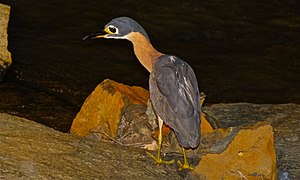White-backed heron
| White-backed heron | ||||||||||||
|---|---|---|---|---|---|---|---|---|---|---|---|---|

White-backed Heron ( Nycticorax leuconotus ) |
||||||||||||
| Systematics | ||||||||||||
|
||||||||||||
| Scientific name | ||||||||||||
| Nycticorax leuconotus | ||||||||||||
| ( Wagler , 1827) |
The white-backed heron ( Nycticorax leuconotus ) is a medium-sized species from the heron family . It occurs exclusively in Africa. The species belongs to the night heron, but it is still not entirely clear whether it actually belongs to the genus Nycticorax . Alternatively, an assignment to Gorsachius is conceivable. The white-backed heron is a widespread, but nowhere common species. The population is not known.
Appearance
The white-backed heron reaches a height of 50 to 56 centimeters. The head is black and has a short, tight bonnet. The eyes are relatively large and are surrounded by a white field of vision and a striking yellow eye ring. The beak is black, the lower base of the beak is yellow. The irises are yellow. The chin is white and the neck is auburn. The back is dark brown-black. The upper elytra are brown, the wings are gray-black. The legs and feet are greenish to orange-yellow. During the breeding season, the color of the iris changes to a red, brown, amber, and then yellow. The consequence of this change in color has not yet been adequately described.
Distribution area and habitat
The white-backed heron is a species found in sub-Saharan Africa. It breeds from Senegal , Gambia , Guinea-Bissau over the Ivory Coast and Nigeria, Gabon , Sudan, Ethiopia, Congo, Tanzania, Uganda , Botswana , Zambia , Zimbabwe , Malawi and Mozambique to the north of Angola and the east of South Africa. The white-backed heron is a resident bird. However, it cannot be ruled out that depending on rainfall it may also migrate within its area of distribution.
The white-backed heron is a species of heron that is tied to the forest and mostly lives individually. It occurs wherever dense forest borders directly on the water. During the day it rests in dense swamp or forest vegetation and often sits high up in the trees.
Way of life
The white-backed heron is a predominantly nocturnal species. It looks for its food mainly on the edge of the water and in mud banks as well as in belts of reeds. Mostly they stay in the vicinity of dense vegetation. Both adult and juvenile birds adopt the pole position of tommels when they feel disturbed. Its food spectrum has not yet been adequately investigated. But it does eat fish, amphibians, mussels and insects, among other things.
The breeding season is seasonally variable and usually coincides with the peak of the annual floods. The clutch usually consists of two to three eggs. The breeding season is 24 to 26 days. The young birds do not leave the nest until they are six to seven weeks old.
supporting documents
Single receipts
- ↑ Kushlan et al., P. 273
literature
- James A. Kushlan & James A. Hancock: Herons . Oxford University Press, 2005, ISBN 0-19-854981-4
Web links
- Calherodius leuconotus onthe IUCN 2013 Red List of Threatened Species . Listed by: BirdLife International, 2012. Retrieved September 5, 2013.